Elderflower cordial (aka zova or bazga) is a flavorful and aromatic (non-alcoholic) homemade syrup made with delicate elderflowers. Popular in late spring and summer, this delicious beverage is a perfect upgrade to lemonade. Shall we?
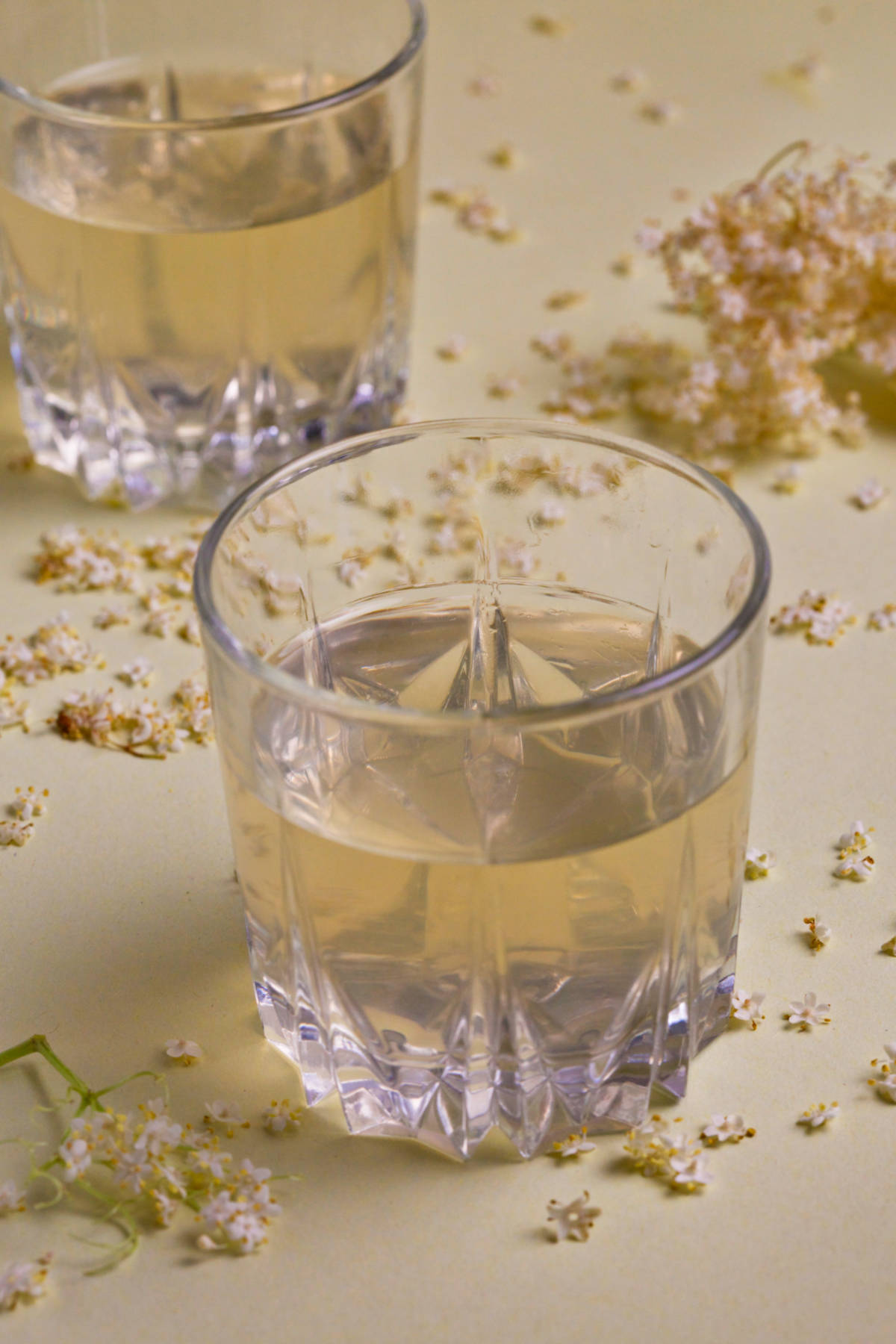
Jump to:
Background
When the elderflower (zova, bazga) blossom pokes its head in late spring, Balkan households get busy preparing elderflower cordial. Because of its light, floral, and endlessly refreshing taste, this sunshine in a bottle is loved from the first gulp.
Elderflower cordial is essentially a sweet syrup. When mixed with still or sparkling water, it transforms into a delicious juice. It perfectly complements lighter summer meals and desserts. (Meat-centric dishes too!)
Most people love elderflower cordial from the first try. Due to its efflorescent, springtime aroma, elderflower cordial (zova) evokes sunny days the same way cinnamon does the snowy ones.
While it takes a couple of days for elderflowers to infuse the water and transform into a syrup, the process is easy. The wait for the deliciousness is the hardest part. ☺️ As always, we'll guide you step by step.
Important! Before making elderflower syrup, make sure your elderflowers are: 1. completely free of chemical pesticides (to avoid poisoning), and 2. cultivated away from the streets (to avoid pollution).
Why You'll Love Elderflower Cordial (Zova, Bazga)
- Nostalgic! Zova (bazga) is familiar in an unfamiliar way. It tastes like endless summer days at nana's.
- Versatile! Mix it with still or sparkling water, add it to cocktails, add to baklava or other desserts, pour over ice cream... the sky is the limit.
- Longlasting! Properly stored (in a dark, cool place), elderflower cordial lasts up to six months.
Ingredients
You know we love you! This is why most of our recipes use only the fundamentals. Like our elderflower cordial (zova, bazga):

- Elderflower heads. Each elderflower head is the size of a palm of a hand, and contains hundreds of small elderflowers. You'll need about 40-ish of these heads. They must be free of chemical pesticides, and cultivated away from roads and highways.
- Lemon. Juice only.
- Sugar. Granulated white sugar.
- Citric Acid (Sour Salt). Citric acid helps preserve the syrup so it can last a long time. Can't find it? Look in the spice or canning sections of your grocery store. It goes by either of those names.
Instructions
Here are simple directions to make this amazing elderflower cordial.
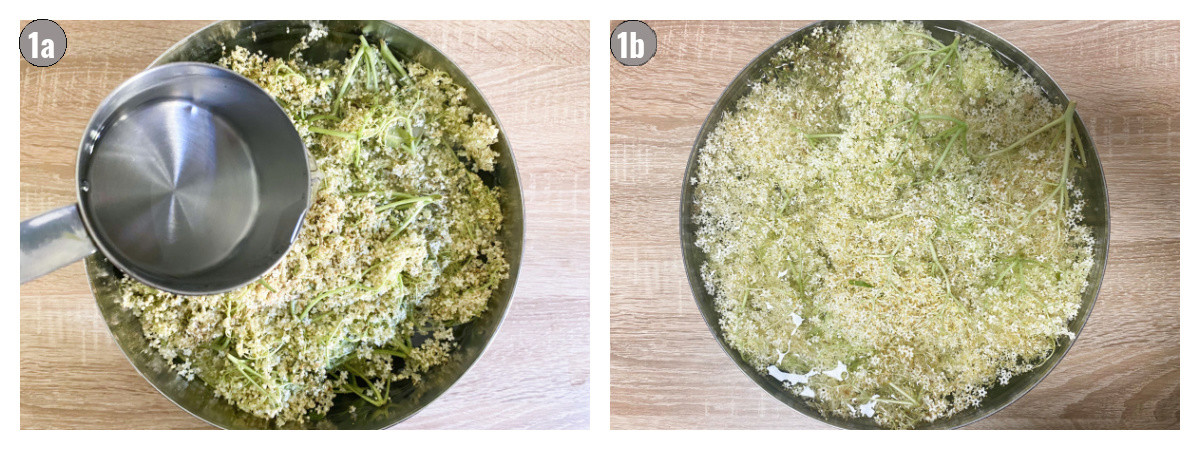
Step 1. Place elderflower heads in a large bowl, add water, and cover with a tray. Leave for 24 hours.
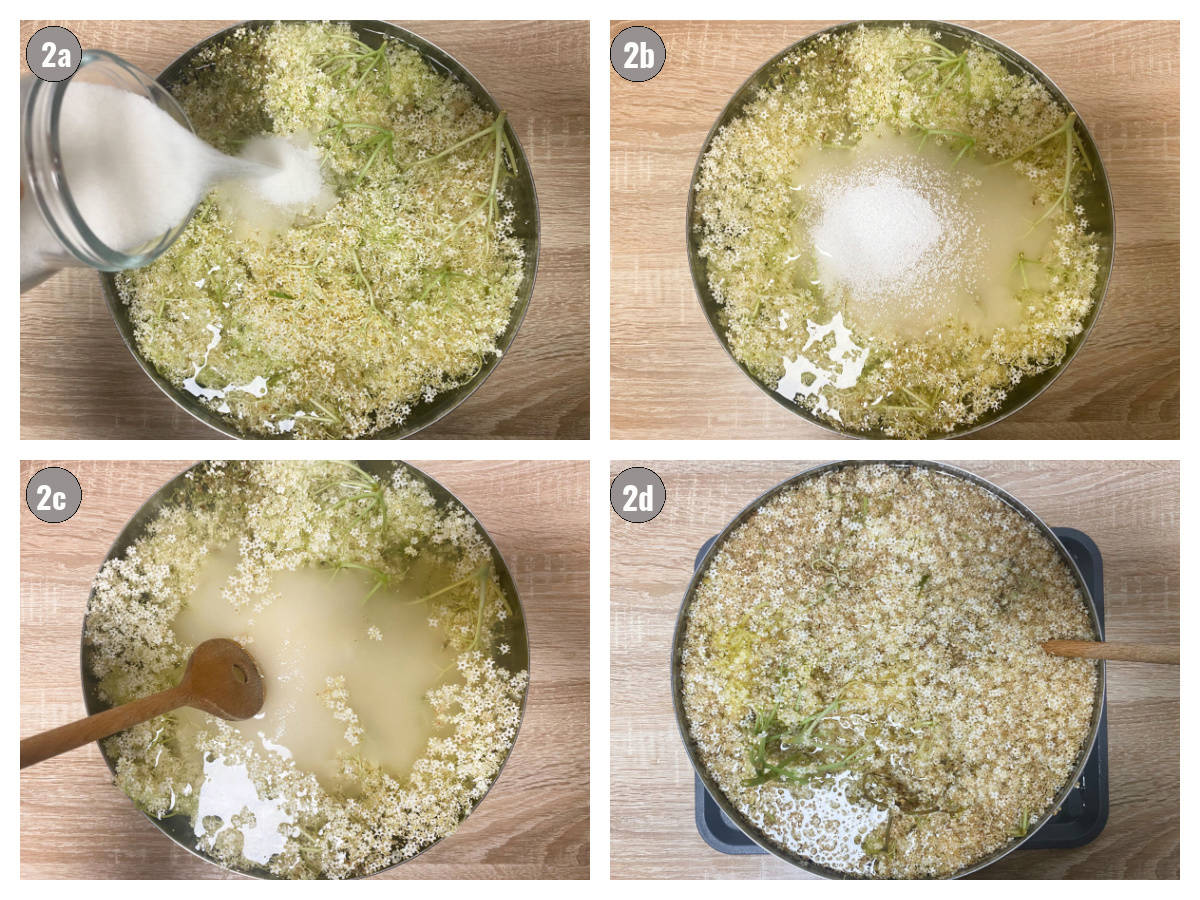
Step 2. The next day, add sugar and citric acid. Let it sit for another 24 hours, stirring a few times.
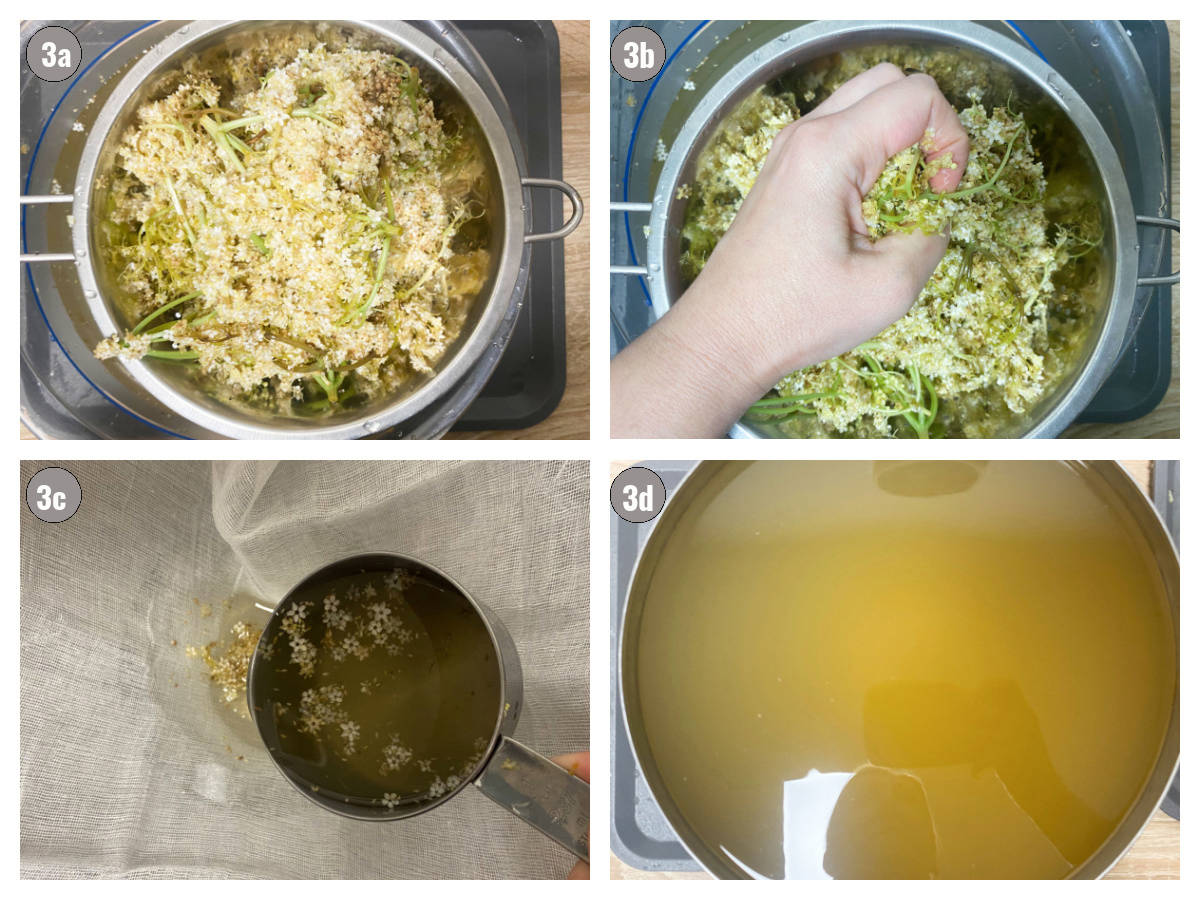
Step 3. On the third day, strain the liquid.
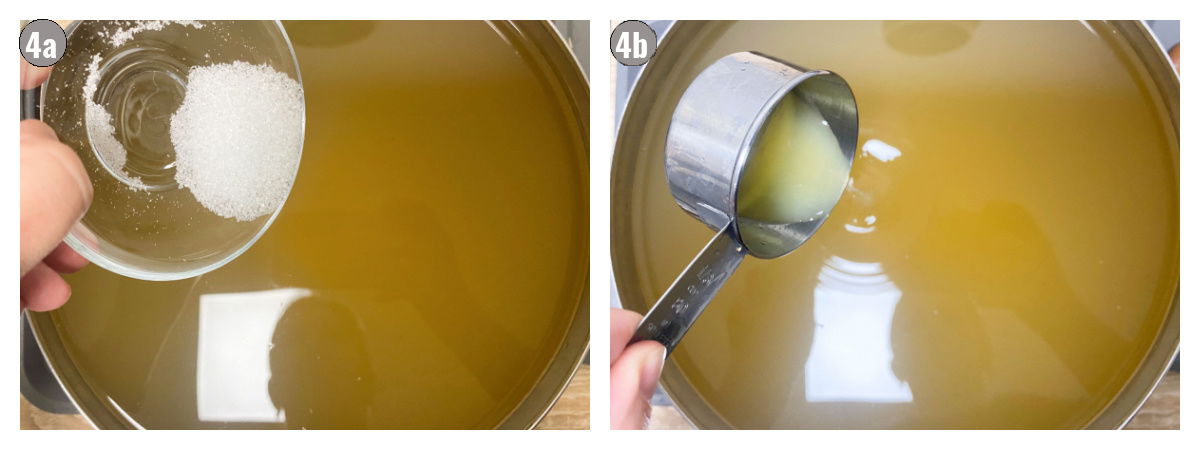
Step 4. Also, discard flowers, add more citric acid, and the juice of one lemon. Stir and let sit for one hour.
Steps 5 & 6. (Not pictured.) Heat the oven. Wash bottles and place them on a baking pan to sterilize. Carefully remove bottles from the oven and pour the syrup in. Store.
Handling
Storing: Store elderflower cordial (bazga) in a cool, dark place for up to six months. Once opened, keep the bottle in the fridge and use within 2–3 weeks.
Serving: To serve, pour about ¼–½ cup (or per taste) of syrup into a glass. Dilute with still or sparkling water. Garnish with lemon or mint.
Expert Tips
Here are a few tips that simplify the process of making elderflower syrup even more.
- Ingredient Volumes.
Elderflower cordial is a forgiving syrup. Ingredient volumes don't need to be precise. In fact, after you make zova (bazga) a few times, you'll find you prefer a specific flavor of it (sweeter, more sour, etc.).
Many old-school Balkan zova (bazga) recipes call for 4 liters of water and 4 kilograms of sugar to 500 grams (40 heads) of elderflowers. (That's approximately 1 gallon of water to 18-20 cups of sugar, plus 1 pound of elderflowers.)
We find that using (quite a bit) less sugar is completely fine. The only ingredient that should stay the same (or be increased) is the citric acid. Citric acid (sour salt) preserves the syrup, and without it, the elderflower cordial will not last for more than a few days. Putting too much of it, however, can make the syrup too sour.
- Choosing Elderflowers
Always, always, always choose elderflowers that have not been treated with chemical pesticides, and have been cultivated away from the street and highway pollution. This is crucial for your health.
More Beverages We ❤️
Elderflower cordial (zova, bazga) is only one of our favorite drinks. Here are a few more homemade beverages that make our lives happier.
Thoughts
If you make today’s elderflower cordial (zova, sok od zove, bazga, sok od bazge) and love it, please consider leaving a ⭐️⭐️⭐️⭐️⭐️ (5-star) rating—it helps others find the recipe more easily!
You can also leave a comment; I read every single one! And if Instagram is more your thing, tag us @balkanlunchbox—we’d love to see your creations.
Prijatno, Dobar Tek, and Bon Appétit!
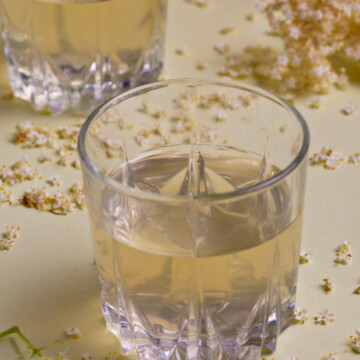
Elderflower Cordial (Zova, Bazga)
Equipment
- 4-5 34-ounce (1-liter) glass bottles with lids
Ingredients
- 30-40 elderflower heads (about 1lb/ 500g) must be without pesticides, grown away from a road or a street; one elderflower head is about the size of a palm
- 16 cups water
- 9 cups of sugar also, more sugar is fine for thicker syrup
- 3.5 tablespoons citric acid (sour salt), divided also goes by limuntos
- 1 lemon juice only
- (Optional) lemon slices, mint leaves for garnish when serving
Instructions
- Place elderflower heads into a large bowl and cover with 16 cups of water. (If you wish, you can cover the bowl with a kitchen towel or a tray to avoid anything falling in.) Leave at room temperature for 24 hours.
- The following day, add sugar and 1 tablespoon of citric acid to the flowers in water. Lightly stir. Leave for 24 hours, however, stir well a few more times during the day.
- On the third day, strain the juice through a colander into a different bowl. Once you've strained the liquid, also squeeze the elderflower heads well to get all the liquid out of them. (Optionally, strain one more time through a gauze to remove any leftover tiny flowers from the syrup. If they don't bother you, leave them.)
- Discard used elderflower heads, then add the remaining citric acid and lemon juice to the syrup. (You can taste the syrup to see if the acidity versus sugar combination is to your taste. Feel free to add more lemon juice or citric acid.) Stir really well, and let the juice sit for one hour.
- Heat oven to 220°F (100°C). Thoroughly wash glass bottles and their lids in soapy water. Rinse and pat dry. Place bottles (not the lids) on a thin pan, and then place the pan in the oven for about 15-25 minutes. This will sterilize them.
- Carefully take the pan with glass bottles out of the oven. Protecting your hands with oven mittens, pour the elderflower syrup into the bottles, and secure with lids. Leave in a cool, dark place for up to 6 months. Once you open the bottle, transfer it to the fridge and keep for 2-3 weeks.
- Once ready to serve, simply pour your desired amount of syrup (about ¼–½ cup, or per taste) into a glass, then top with still or sparkling water. Finish with a garnish of fresh lemon slices or mint leaves.
Notes
- Preparation Time
- Ingredients
- Ingredient Volume
- Nutritional Information


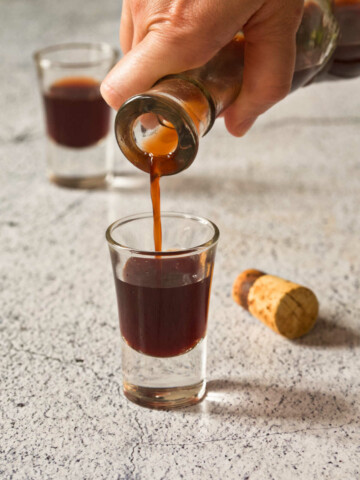
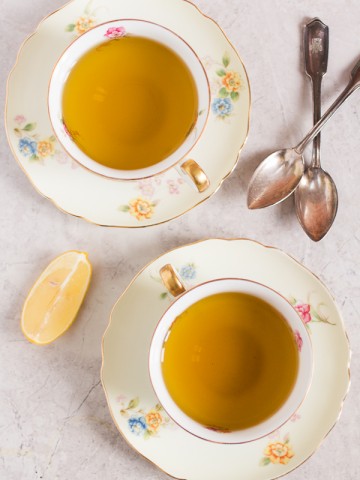

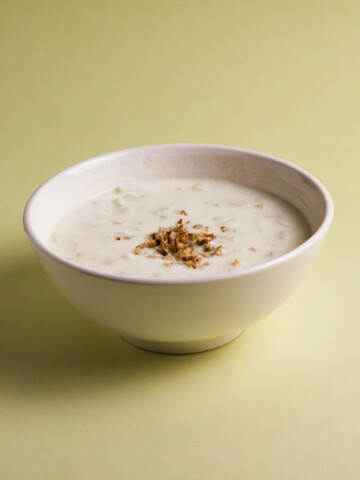
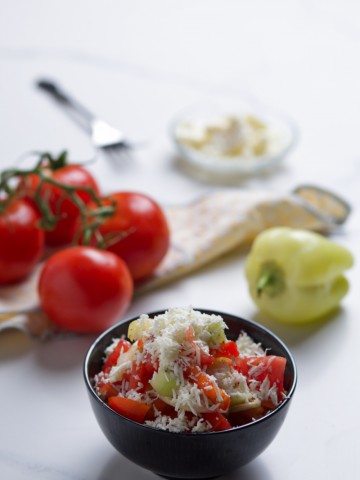
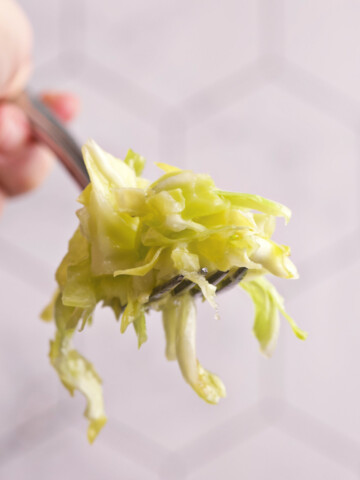

Cooking with Zoki says
Blago tebi kad si je našla....ja je ovde nisam nigde videla, ili je ne raspoznajem a tako bih volela da napravim taj sokić...ma izgleda da me drma nostalgija i posle 42 godine provedenih u Kanadi.
Videla sam je kod jedne žene u dvorištu i pitala sam je da mi da mali izdanak zove i žena mi dade, e sad, koliko će proći dok moja zova poraste i cveta, tek joj je druga godina i još uvek je mala a dotle ću uživati u ovim tvojim prelepim fotkicama a tebi neka je u zdravlje ovaj napitak.
Aida says
Hvala puno Zoki! Trenutno sam u Sarajevu, gdje je prodaju na sve strane. U Americi obicno nadjem zovu na "farmer's market"-u, a evo nasla sam i sajt odakle se sok izgleda moze naruciti iz NJ (new jersey-a). Nije Kanada, ali je blize nego odavde. (http://www.belvoirfruitfarms.com/contact/) Hvala puno sto ste posjetili blog, i vas je veoma lijep. Imate oko za estetiku - servirate kao da je svaki dan praznik. 🙂